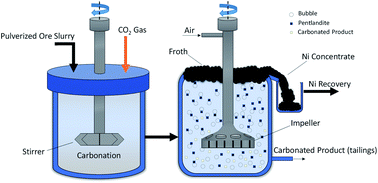Mineral carbonation for serpentine mitigation in nickel processing: a step towards industrial carbon capture and storage†
Abstract
A proof-of-concept for the carbonation-assisted processing of ultramafic nickel ores is presented. Carbonation converts serpentine, the primary gangue or undesirable mineral, to magnesite. It prevents slime coating of fine gangue minerals on pentlandite, the main nickel-bearing mineral, during froth flotation, and improves nickel recovery and concentrate grade. Additionally, CO2 is captured and stored in the form of solid carbonates, thus removing it from the atmosphere. Microflotation experiments demonstrated improved nickel recovery (61.2 to 87.4 wt%) and concentrate grade (20.6 to 24.7 wt%) in carbonated vs. uncarbonated systems. The mechanism behind the improved nickel flotation was investigated by zeta potential measurements, optical imaging microscopy, X-ray photoelectron spectroscopy and time-of-flight secondary ion mass spectrometry. These analyses confirmed the absence of slime coating in the carbonated system under the flotation conditions tested. Finally, a preliminary techno-economic analysis was performed to evaluate the cost metrics of incorporating carbonation into nickel mineral processing.

- This article is part of the themed collection: Carbon dioxide utilisation


 Please wait while we load your content...
Please wait while we load your content...